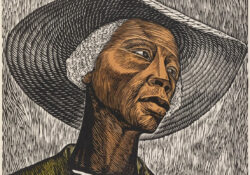
Poetry rang out through the stacks of the Central Library one night in July. Community members filled the gallery space on Level 8 for the soft opening of the new exhibit, “Black Activism in Print: Visual Art from the African American Collection.”
One by one, members of the African American Writers’ Alliance (AAWA) strode to the podium to share original poems based on the prints displayed in the gallery. Like the prints, the poetry honored a legacy of Black culture deeply rooted in Seattle — and at the library in particular.
The Douglass-Truth Branch, situated in the historic Central District, is home to one of the West Coast’s largest collections of African American literature and history: more than 10,000 items and growing. The collection — and the name and existence of the branch itself — is due mainly to the work of Black activists in the 1960s.
Taylor Brooks, African American Collection and Community Engagement Librarian at the Douglass-Truth Branch, sought a way to elevate this significant history. The African American Collection was established in 1964 at what was then called the Yesler Branch, thanks to a donation from the local chapter (Delta Upsilon Omega) of the Alpha Kappa Alpha sorority (AKA). The donation also included prints by prominent Black artists Charles White and Elizabeth Catlett.
Brooks was struck by the double meaning of “print,” applying both to books and the dynamic visual art medium. She found the printmaking of White and Catlett incredibly thought-provoking and pertinent to conversations related to art and accessibility.
“Looking at these prints, I see the tenacity of the women who built this collection,” Brooks said.
The Yesler Branch faced possible closure in the 1960s. AKA members and community leaders, including Roberta Byrd Barr, Dr. Millie Russell, and Ruth Marie Brown, fought to keep the library open and turn it into a center for Black achievements, history, and culture.
This advocacy created the collection, saved the branch, and later led to its renaming in honor of Frederick Douglass and Sojourner Truth. Brooks wanted the exhibit to spotlight Barr, Russell, Brown, and their central role in library history. She began working with AKA historian Crystal Tolbert Bell, visual artist and Black Arts Legacy honoree Esther Ervin, and others to bring the exhibit to life.
In addition to the prints by White and Catlett, the gallery features original documents from the struggle to save the branch and artifacts such as original teacups used by AKA members in the annual “library tea” event at Douglass-Truth. An episode of “Face to Face,” the weekly Seattle television show Barr moderated from 1965 to 1972, plays on a loop in a corner.
The pieces certainly resonated with visiting community members. Several AAWA writers shared poems inspired by Catlett’s striking print “Sharecropper.” Dr. Georgia McDade, a charter member of AAWA, spoke to what it meant to have a platform for these works. “I never thought I would see the African American Collection on display not just at our library but at the Central Library,” she said. “I’m in heaven.”
For decades, AKA members funded and supported the African American Collection at Douglass-Truth. Thanks to donor support, the sorority still sponsors and helps grow the collection. The TEW Foundation, based in Seattle, is funding the current exhibit and its travel to other branches in the future.
“Black Activism in Print” runs at the Central Library Level 8Gallery until September 15. After that, the items will be on display as part of the African American Collection at the Douglass-Truth Branch and at more library branches in 2024. To learn more, visit spl.org/Exhibits.
Your gift to the Foundation helps preserve Seattle history and elevate community voices through library collections, exhibits, and programs. Give today!
